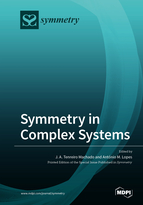Symmetry in Complex Systems
A special issue of Symmetry (ISSN 2073-8994). This special issue belongs to the section "Computer".
Deadline for manuscript submissions: closed (31 December 2019) | Viewed by 20946
Special Issue Editors
Interests: nonlinear dynamics; complexity; fractional calculus; modeling; control; entropy; genomics
Special Issues, Collections and Topics in MDPI journals
Interests: complex systems modelling; automation and robotics; fractional order systems modelling and control; data analysis and visualization
Special Issues, Collections and Topics in MDPI journals
Special Issue Information
Dear Colleagues,
Complex systems with symmetry arise in many fields, at various length scales, including financial markets, social, transportation, telecommunication and power grid networks, world and country economies, ecosystems, molecular dynamics, immunology, living organisms, computational systems, and celestial and continuum mechanics. The emergence of new order and structures in complex systems means symmetry breaking and transitions from unstable to stable states. Modeling complexity has attracted many researchers from different areas, dealing both with theoretical concepts and practical applications.
This Special Issue seeks to fill the gap between the theory of symmetry-based dynamics and its application to model and analyze complex systems. We welcome submissions addressing novel issues, as well as those focused on more specific topics, illustrating the broad impact of symmetry-based dynamics in complex systems.
The main topics of interest include (but are not limited to):
- Complex systems
- Symmetry-breaking
- Complex Networks
- Nonlinear dynamical systems
- Bifurcation theory
- Synchronization
- Entropy and Information Theory
- Fractional calculus and its applications
- Evolutionary computing
- Finance and economy dynamics
- Fractals and chaos
- Biological systems and bioinformatics
- Nonlinear waves and acoustics
- Geosciences
- Astronomy and cosmology
- Nuclear physics
Prof. Dr. J. A. Tenreiro Machado
Prof. Dr. António M. Lopes
Guest Editors
Manuscript Submission Information
Manuscripts should be submitted online at www.mdpi.com by registering and logging in to this website. Once you are registered, click here to go to the submission form. Manuscripts can be submitted until the deadline. All submissions that pass pre-check are peer-reviewed. Accepted papers will be published continuously in the journal (as soon as accepted) and will be listed together on the special issue website. Research articles, review articles as well as short communications are invited. For planned papers, a title and short abstract (about 100 words) can be sent to the Editorial Office for announcement on this website.
Submitted manuscripts should not have been published previously, nor be under consideration for publication elsewhere (except conference proceedings papers). All manuscripts are thoroughly refereed through a single-blind peer-review process. A guide for authors and other relevant information for submission of manuscripts is available on the Instructions for Authors page. Symmetry is an international peer-reviewed open access monthly journal published by MDPI.
Please visit the Instructions for Authors page before submitting a manuscript. The Article Processing Charge (APC) for publication in this open access journal is 2400 CHF (Swiss Francs). Submitted papers should be well formatted and use good English. Authors may use MDPI's English editing service prior to publication or during author revisions.
Keywords
- Complex systems
- Symmetry-breaking
- Bifurcation theory
- Complex Networks
- Nonlinear dynamical systems







